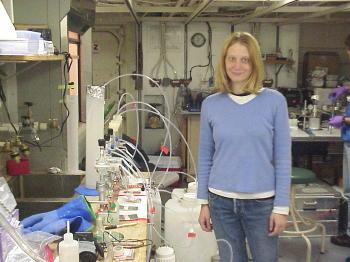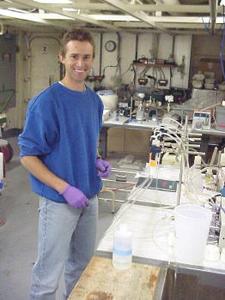
|
|
1 August, 2002
As I prepared to post the journal for July 31 on time
(it was actually 11PM on the 31st) we lost our
connection to the internet. That makes one more
reason for my often tardy journals. I suspected it
might happen as the ship suddenly began to move to
find a better area (less ice covered) to deploy the
CTD. Since that was just before midnight and several
people needed to sample, including four hours of
pumping, I went to bed. This morning I found that I
still had time before my sediment work, so I had a
chance to do my laundry and to talk with two more of
the scientists on board.
Laura Belicka and Karl Kaiser work in a lab just off
the main science lab. They are sampling water to
trace the sources and the fate of organic carbon.
Remember that organic carbon is that carbon which is
found in living things. When Laura and Karl talk
about the fate of the carbon, they are looking at how
it can be changed into other forms. It might be
broken down, eaten, or even end up at the bottom in
the sediments. Basically, they want to know where the
carbon came from and where it is going. Laura is a
faculty research assistant at the Chesapeake
Biological Laboratory, a part of the University of
Maryland Center for Environmental Science where she
works with Rodger Harvey. She collects water from the
CTD casts and sediments from a very large box core
(see the picture below). Itís much bigger than the
van Veen that we use to get mud! She filters the
water and examines the parcticles left behind on the
filter. Karl then looks at what is left, the
dissolved organic matter. Both Karl and Laura are
analyzing for special biomarkers. Lipids, one type of
biomarker, are fat-like molecules found in all living
things. For example, they are always found in the
membranes that surround all cells in our bodies. In
addition, they contain carbon. A biomarker is a
substance that is found only in one type of organism
thus making it easier to figure out where it came
from. For example, cholesterol is a lipid but itís not
a good biomarker since so many different organisms
contain it. One lipid bio marker that Laura looks for
is dinosterol, a lipid produced by tiny plankton
called dinoflagellates.
There are two sources of organic carbon in the Arctic
Ocean. One is from within the ocean itself (marine)
and one is from land (terrestrial). The marine carbon
comes from primary production on the shelf. This is
where the phytoplankton come in. Remember that
phytoplankton are plants and plant-like plankton that
make their own food and food for others by using the
carbon dioxide (CO2) in the air or dissolved in the
ocean. The process is called photosynthesis. Thereís
lots of food production on the shelf because the water
is shallow enough for light to reach the phytoplankton
(they need the light for photosynthesis), and there
are plenty of nutrients there to help the
phytoplankton grow. Terrestrial carbon comes into the
Arctic Ocean by way of fresh water rivers. The Yukon
and the Mackenzie are the two largest Alaskan rivers,
but several Russian rivers also empty into the Arctic
Ocean. Marine carbon is consumed very fast, but
terrestrial carbon is older and resistant to change.
Laura and Karl use biomarkers to distinguish between
these two sources of carbon.
Lauraís work is with the parcticles that she filters
from the water. This parcticulate carbon makes up only
5-10% of the carbon in the ocean. The dissolved
carbon with which Karl works makes up almost 90% of
the ocean carbon. Karl emphasized that there is a
huge amount of organic carbon that we know very little
about; the chemical structure is essentially unknown.
Laura will filter her water here and collect
sediments. Once she is back in her lab, she will
extract (take out) the lipids from the parcticles and
from the sediments. On ship, her work takes about
three hours/sample. At home in her lab, she will
separate out the lipids, often getting several hundred
different lipids in each sample. To complete the
analysis, she will need about three weeks to do each
set of 12 samples. The two SBI cruises (spring and
summer 2002) combined will give her about 100 parcticle
samples and 240 sediment samples. She has a lot to do
when she gets home!
Karl is a research associate at the University of
South Carolina where he works with Ron Benner. Karlís
goal on this cruise is to gather data for comparison
with the data from the spring SBI cruise and to look
more closely at an unexpected observation from the
spring cruise. In the spring, scientists on board the
Healy observed an unusual layer of water at a depth of
approximately 130 meters, going over the slope and
into the basin. Test results tell them that this
water is probably 900-1500 years old, and they would
like to identify the source. Is it marine or
terrestrial? Thereís even a possibility that the
source could be fresh water rivers. The question then
would be how could it stay that long? There are many
questions to be answered about this water mass and
about the Arctic Ocean in general. Thatís why this
SBI project is so important. Hopefully, after more
cruises in 2004 and discussions with scientists from
other nations who are conducting research in the
Arctic Ocean, scientists will be able to answer some
of these questions.
Karl, like Laura, will complete his analysis once he
returns to his lab. He estimates he can analyze eight
samples in a week, and he will have 200 samples from
the two SBI cruises. Many people donít realize that
the process of science is often time consuming and
repetitive. Scientists gather data, analyze it and
repeat their work many times to make sure their
results are accurate. Often their work leads not
directly to answers but instead to more questions.
Even when they find ďanswersĒ new information may
cause them to re-examine their findings. While Iíve
been on this cruise, Iíve had a chance t observe the
day to day work of these scientists as they carefully
gather data, start the long process of analysis and
document their findings. That often means long days
and nights in the lab or on deck. They are working
hard while out here for 40 days, and their work will
continue once they get home.

Laura Belicka takes water from the CTD casts and filters it to remove the parcticles. She's analyzing the parcticles for lipid biomarkers (check the journal for an explanation).

Laura also uses this large box core to get the sediments she needs for her work.

Karl Kaiser analyzes the water that remains after Laura has filtered out the parcticles. Both Karl and Laura are sampling the water to trace the sources and the fate of organic carbon (where it comes from and what happens to it.)
Contact the TEA in the field at
.
If you cannot connect through your browser, copy the
TEA's e-mail address in the "To:" line of
your favorite e-mail package.
|
